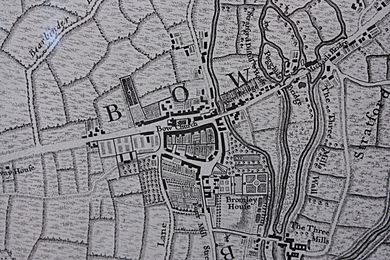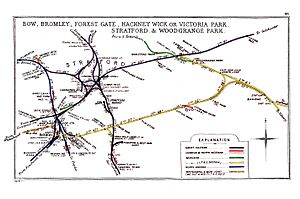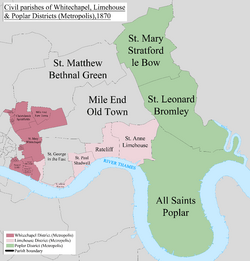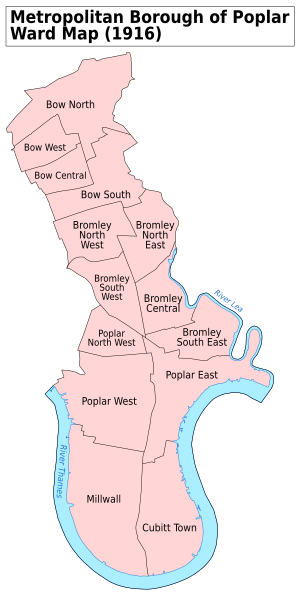Bow, London facts for kids
Quick facts for kids Bow |
|
|---|---|
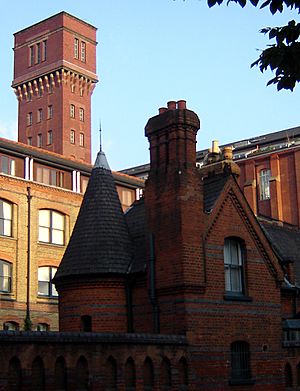 Former Bryant and May match factory |
|
| Population | 27,720 (2011 census Bow East and Bow West wards) |
| OS grid reference | TQ365825 |
| • Charing Cross | 4.6 mi (7.4 km) W |
| London borough | |
| Ceremonial county | Greater London |
| Region | |
| Country | England |
| Sovereign state | United Kingdom |
| Post town | LONDON |
| Postcode district | E3 |
| Dialling code | 020 |
| Police | Metropolitan |
| Fire | London |
| Ambulance | London |
| EU Parliament | London |
| UK Parliament |
|
| London Assembly | |
Bow (/ˈboʊ/) is a district in East London, England and is in the London Borough of Tower Hamlets. It is an inner-city suburb located 4.6 miles (7.4 km) east of Charing Cross.
Historically in Middlesex, it became part of the County of London in 1888. "Bow" is an abbreviation of the medieval name Stratford-at-Bow, in which "Bow" refers to the bow-shaped bridge built here in the early 12th century. Bow contains parts of both Victoria Park and the Queen Elizabeth Olympic Park. Old Ford and Fish Island are localities within Bow, but Bromley-by-Bow immediately to the south is a separate district. These distinctions have their roots in historic parish boundaries.
Bow underwent extensive urban regeneration including the replacement or improvement of council homes, with the impetus given by the staging of the 2012 Olympic Games at nearby Stratford.
Contents
History
Bridges at Bowe
Stratforde was first recorded as a settlement in 1177, the name derived from its Old English meaning of paved way to a ford. The ford originally lay on a pre-Roman trackway at Old Ford about 600 metres to the north, but when the Romans decided on Colchester as the initial capital for their occupation, the road was upgraded to run from the area of London Bridge, as one of the first paved Roman roads in Britain. The 'paved way' is likely to refer to the presence of a stone causeway across the marshes, which formed a part of the crossing.
In 1110 Matilda, wife of Henry I, reputedly took a tumble at the ford on her way to Barking Abbey, and ordered a distinctively bow-shaped, three-arched bridge to be built over the River Lea, The like of which had not been seen before; the area became known variously as Stradford of the Bow, Stratford of the Bow, Stratford the Bow, Stratforde the Bowe, and Stratford-atte-Bow' (at the Bow) which over time was shortened to Bow to distinguish it from Stratford Langthorne on the Essex bank of the Lea. Land and Abbey Mill were given to Barking Abbey for maintenance of the bridge, who also maintained a chapel on the bridge dedicated to St Katherine, occupied until the 15th century by a hermit. This endowment was later administered by Stratford Langthorne Abbey. By 1549, this route had become known as The Kings Way.
Responsibility for maintenance of the bridge was always in dispute, no more so than with the Dissolution of the Monasteries, when local landowners who had taken over the Abbey lands were found responsible. The bridge was widened in 1741 and tolls were levied to defray the expense, but litigation over maintenance lasted until 1834, when the bridge needed to be rebuilt and landowners agreed to pay half of the cost, with Essex and Middlesex sharing the other. The bridge was again replaced in 1834, by the Middlesex and Essex Turnpike Trust, and in 1866 West Ham took responsibility for its upkeep and that of the causeway and smaller bridges that continued the route across the Lea. In 1967 this bridge was replaced by a new modern bridge by the Greater London Council who also installed a two-lane flyover above it spanning the Blackwall Tunnel approach road, the traffic interchange, the River Lea and some of the Bow Back Rivers. This has since been expanded to a four-lane road.
Religious life
Anglican churches
St Mary Stratford Bow

In 1311 Bow remained an isolated village, often cut off from St Dunstan's, Stepney church by flood. Permission was given to build a chapel of ease to allow the residents a local place to worship. The land was granted by Edward III, on the King's highway, thus beginning a tradition of island church building.
In 1556, during the reign of Mary I of England and under the authority of Edmund Bonner, Bishop of London, many people were brought by cart from Newgate and burned at the stake in front of Bow Church, in one of the many swings of the English Reformation.
In 1719, the parish became independent of Stepney and St Mary Stratford Bow consecrated. The parish included the Old Ford area, which has also been known as North Bow.
Catholic churches
The Guardian Angels
Located at 377 Mile End Road, E3 the church building by Frederick Arthur Walters was opened in 1903, paid for by the then Duke of Norfolk as a memorial to Lady Margaret Howard, who had performed charitable work in the East End.
The Holy Name & Our Lady of the Sacred Heart
Located at 117 Bow Common Lane, E3 the church building by Frederick Arthur Walters opened in 1894. The parish is home to the Vietnamese chaplaincy in the Archdiocese of Westminster.
Our Lady & St Catherine of Sienna
Located at 179 Bow Road, E3, the church building by Gilbert Blount opened in 1870. Formerly the parish was run by a community of Dominican nuns, Nowadays the parish is run by the Archdiocese of Westminster.
Chaucer and Stratford-atte-Bowe
A convent of Benedictine nuns was established at the nearby Priory of St Leonards, in modern Bromley-by-Bow. Geoffrey Chaucer immortalised this Priory in his Canterbury Tales: This was a joking (Jill Mann, The Canterbury Tales, Notes to the General Preface) reference to the Prioress having learned the distinctive Anglo-Norman dialect of French, from the Benedictine nuns. French still had the cachet of being the language of the royal court, but "English French" was by then considered rustic compared to the French of Paris. (see Bromley-by-Bow).
Bow porcelain
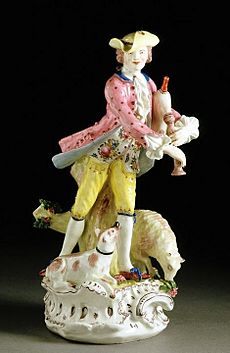
During the 17th century Bow and the Essex bank became a centre for the slaughter and butchery of cattle for the City market. This meant a ready supply of cattle bones, and local entrepreneurs Thomas Frye and Edward Heylyn developed a means to mix this with clay and create a form of fine porcelain, said to rival the best from abroad, known as Bow Porcelain.
The Bow China Works prospered, employing some 300 artists and hands, until about 1770, when one of its founders died. By 1776 all of its moulds and implements were transferred to a manufacturer in Derby. In 1867, during drainage operations at the match factory of Bell & Black at Bell Road, St. Leonard's Street, the foundations of one of the kilns were discovered*, with a large quantity of 'wasters' and fragments of broken pottery. The houses close by were then called China Row, but now lie beneath modern housing. Chemical analysis of the firing remains showed them to contain high quantities of bone-ash, pre-dating the claim of Josiah Spode to have invented the bone china process. More recent investigations of documentary and archaeological evidence suggests the concern was to the north of the High Street and across the river.
Bryant and May
In 1888, the match girls' strike occurred at the Bryant and May match factory in Fairfield Road. This was a forerunner of the suffragette movement fight for women's rights and also the trade union movement. The factory was rebuilt in 1911 and the brick entrance includes a depiction of Noah's Ark and the word 'Security' used as a trademark on the matchboxes. Match production ceased in 1979 and the building is now private apartments known as the Bow Quarter.
Suffragettes
Emmeline Pankhurst began the Women's Social and Political Union (WSPU) in 1903 with her daughters Christabel and Sylvia. Sylvia became increasingly disillusioned with the Suffragette movement's inability to engage with the needs of working-class women like the match girls. Sylvia formed a breakaway movement, the East London Federation of Suffragettes, and based at 198 Bow Road, by the church, in a baker's shop. This was emblazoned with "Votes for Women" in large gold letters, and opened in October 1912. The local Member of Parliament, George Lansbury, resigned his seat to stand on a platform of women's enfranchisement. Sylvia supported him and Bow Road became the campaign office, culminating in a huge rally in nearby Victoria Park, but Lansbury was narrowly defeated and support for the project in the East End was withdrawn.
Sylvia refocused her efforts from Bow, and with the outbreak of World War I began a nursery, clinic and cost price canteen for the poor at the bakery. A paper, the Women's Dreadnought, was published to bring her campaign to a wider audience. At the close of war, the Representation of the People (Amendment) Act 1918 gave limited voting rights to property-owning women over the age of 30, and equal rights were finally achieved ten years later.
Pankhurst spent 12 years in Bow fighting for women's rights. She risked constant arrest and spent a lot of time in Holloway Prison, often on hunger strike. She finally achieved her aim, and along the way had alleviated some of the poverty and misery and improved social conditions for all in the East End.
Railways
In 1843 the engineer William Bridges Adams founded the Fairfield Locomotive Works, where he specialized in light engines, steam railcars (or railmotors) and inspection trolleys, including the Fairfield steam carriage for the Bristol and Exeter Railway and the Enfield for the Eastern Counties Railway. The business failed and the works closed circa 1872, later becoming the factory of Bryant and May.
Bow was the headquarters of the North London Railway, which opened its locomotive and carriage workshops in 1853. There were two stations, Old Ford and Bow. During World War 2 the North London Railway branch from Dalston to Poplar through Bow was so badly damaged that it was abandoned.
Bow station opened in 1850 and was rebuilt in 1870 in a grand style, designed by Edwin Henry Horne and featuring a concert hall that was 100 ft long (30 m) and 40 ft wide (12 m). This became The Bow and Bromley Institute, then in 1887 the East London Technical College and a Salvation Army hall in 1911. From the 1930s it was used as the Embassy Billiard Hall and after the war became the Bow Palais, but was demolished in 1956 after a fire.
Local government
Bow formed a part of the medieval parish of Stepney until becoming an independent parish in 1719. The parish vestry then undertook this responsibility until a rising population created the need for the Poplar Board of Works in 1855. This was superseded by the Metropolitan Borough of Poplar in 1900 until it was absorbed into the London Borough of Tower Hamlets in 1965.
Between 1986 and 1992 the name Bow applied to one of seven neighbourhoods to whom power was devolved from the council. This resulted in replacement of much of the street signage. Bow West and Bow East are two wards formed in 2002 that incorporate Old Ford and the eastern end of Bethnal Green (to Grove Road, parts of which used to comprise Mile End New Town, north of the Mile End Road). Bow lost its territory south of the Mile End Road to Bromley-by-Bow. These boundary changes are driven by the need to ensure a comparable number of electors for each ward within the borough.
Geography
It is often said that to be a true Cockney you need to be born within earshot of the sound of Bow Bells and that these are the bells of Bow Church in the heart of Bow. However, the saying actually refers to St Mary-le-Bow, which is approximately three miles west on Cheapside, in the City of London. The other central feature of Bow is the bridge across the River Lea. Today it is a four-lane flyover over the Lea and Blackwall Tunnel approach. The old High Street has few active shops and it now known as Bromley High Street, with large-scale postwar housing to the south. The island church remains as a turning point for buses. The Blackwall Tunnel approach roads´ expansion from the two-lane road at the beginning of the 20th century to a six-lane urban motorway has occupied land at the expense of industry. What remains on the eastern side of the road is a canal-side enclave of small businesses and warehouses, with a large supermarket at the canal bridge to Three Mills and has largely considered to be part of Bromley-by-Bow.
Bow has become associated with the E3 postcode district, but a small part is in E15 and the southern half of Cadogan Terrace and all of Victoria Park which is in E9. Most of the E15 section has been changed to E20 because this part covers the Olympic Park. E3 includes Bromley-by-Bow, Old Ford, Mile End and the transpontine Three Mills in Newham. The modern Tower Hamlets wards of west and east Bow are associated more with the postcode than the settlement, and bounded by the Mile End Road in the south; the River Lea to the east; Victoria Park to the north; and Grove Road in the west.
The Hertford Union Canal links the River Lee Navigation and the Regent's Canal, running west from Old Ford Lock, along the south side of Victoria Park and linking at a basin, just to the west of Grove Road and the park, in the north of Mile End.
Nearby places:
Governance and representation
Bow is the north-east part of the London Borough of Tower Hamlets.
For Planning Policy purposes, a Neighbourhood Plan is being prepared for an area referred to as Roman Road Bow. This area affected includes much of Bow and part of Mile End. The Neighbourhood Plan is intended to produce locally specific policies to complement the Tower Hamlets Local Plan. Roman Road Bow Neighbourhood Plan has been initiated by Roman Road Trust, who are a community development organisation which is developing a community led vision for a flourishing high street and community in the area. The Steering Committee for the Roman Road Bow Neighbourhood Plan led the neighbourhood forum who currently meets every three weeks.
Since 2010 Rushanara Ali of the Labour Party is the local MP for the Bethnal Green and Bow constituency.
Community
The first Idea Store, a chain of educational community centres initiated by the Tower Hamlets Council, opened in Bow in 2002.
Roman Road Community Land Trust is an initiative that seeks to protect the diverse community by providing truly affordable housing and aims to create an alternative solution for residents who are being forced out of the area due to increased property prices.
Roman Road LDN is a hyperlocal magazine covering Bow as well as Old Ford and Globe Town and launched as a full-time publication in 2018. In 2019 the magazine had 2,500 subscribers, 10,000 followers on social media, and nearly 100,000 unique readers a year.
The Bow Arts Trust operates a Low Cost Accommodation scheme throughout the area. This provides housing for artists who have an interest in community work to have an affordable working space.
Ability Bow is a specialised gym for those with disabilities or long-term health conditions and offers one-to-one exercise sessions, it has specialist gym equipment with tailored fitness programmes for each member.
Churches
Bow Church (St Mary and Holy Trinity) is the historic parish church. It forms part of the Bow Group of Anglican churches, together with St Paul's, Bow Common; All Hallows, Bow; St Paul's, Old Ford and St Barnabas Bethnal Green. Other local churches include the Roman Catholic Church of Our Lady and St Catherine of Siena, built in 1870, and Victoria Park Baptist Church, built 1872.
Services
A delivery office called the Bow Delivery Office is located in north Bow on Tredegar Road. with mail services provided by Royal Mail. Bow is in the Bow district but also recently partly in the Olympic Park district E20. Since the closure of the East London mail centre in 2012, all inward mail for the E postcode area is now sorted at Romford Mail Centre.
The Bow PDSA Pet Hospital is located on Malmesbury Road.
Education
St Agnes, Chisenhale Olga and Malmesbury primary schools are located in Bow, as is Central Foundation Girls School on Bow Road. Cherry Trees School is a specialist primary school located at Campbell Road in Bow.
Transport
Rail
Bow is connected to the London Underground at Bow Road tube station on the District and Hammersmith & City linesand also the Docklands Light Railway Stratford-Canary Wharf line at Bow Church DLR Station.
Buses
London Buses routes 8, 25, 108, 205, 276, 309, 323, 425, 488, D8, N25 and N205 all operate within the area.
Roads
The A11 (Bow Road) passes east–west in south Bow, linking the area to Aldgate in the west and Stratford in the east. At Stratford, the road meets the A12 where eastbound traffic can continue towards Ilford, the M11 (for Stansted Airport) and destinations in Essex.
Bow is part of the council controlled parking zone and is covered by Zone B and includes all mini zones (B1/2/3) within the district boundaries. Additionally Saturday controls are enforced in north Bow.
Cycling
Bow is on London-wide and National and cycle networks. Public cycling infrastructure in the locale is provided by both Transport for London (TfL) and the London Borough of Tower Hamlets. Routes include:
- National Cycle Route 1 (NCR 1) - a long-distance leisure cycle route between Dover, Kent and the Shetland Islands, Scotland and forms part of the National Cycle Network. The route passes through Victoria Park and Mile End Park on traffic-free shared use paths. In North London, the route runs from Canary Wharf to Enfield Lock.
- Cycle Superhighway 2 (CS2) - a commuter cycling route from Aldgate in the City to Stratford in the east. The route runs signposted, unbroken and traffic-free on cycle track for the majority of the route. The route follows (Bow Road) through Bow, and the track is coloured blue.
- Cycleway between Hackney and the Isle of Dogs - a proposed commuter cycle route made in 2019.
Industry
Bow power station
Bow power station was a major 51.5 MW electricity generating station located in Marshgate Street, Bow. It was constructed by the Charing Cross and Strand Electricity Supply Corporation which had obtained legal powers in 1899 to supply electricity to the City of London in competition with the City of London Electric Lighting Company. It was the first three-phase generating plant in the UK when it opened in 1902. The station transmitted electricity at 10,000 V through underground cables through the districts of Poplar, Mile End and Whitechapel to substations in the City and West End. A characteristic of the station were the 16 circular steel cooling towers, 30 ft (11 m) in diameter and 85 ft (26 m) high. Coal was delivered to the power station along the River Lea and its channels.
In 1925 Bow became part of the London Power Company (LPC). The LPC wished to consolidate electricity generation in a small number of high output station including Bow. The other stations were Deptford Power Station started in 1925 and completed in 1929 and Battersea A Power Station started in 1929 and completed in 1934. Bow power station was rebuilt and re-equipped several times. Upon nationalisation of the electricity industry in 1948 ownership of Bow power station was transferred to the British Electricity Authority (1948–55), and finally to the Central Electricity Generating Board (1958–69).
Bow power station closed in 1969 and was subsequently demolished.
Notable people
The following people have lived, or currently live or had an education, in Bow:
Actors and entertainers
- Donald Crisp (1882 to 1974) – award-winning actor, born in Bow.
- Graham Norton – comedian and television presenter; lives in Bow
- Danny Wallace – filmmaker, comedian, writer, actor, and presenter of radio and television; lives in Bow.
- Roger Allam – actor known for ITV's Endeavour, born in Bow.
Authors
- Rosa Nouchette Carey (1840-1909) – children's novelist; born in Stratford-le-Bow
- Kia Abdullah – author; born in Mile End, went to school in Bow.
Musicians
- Amy Winehouse (1983 to 2011) – jazz singer-songwriter; had a flat in Bow.
- Dizzee Rascal - grime MC, from Bow.
- Tinchy Stryder - grime MC, from Bow
- Wiley - grime MC, pioneer and record producer, from Bow.
Sportspeople
- Ashley Cole – footballer, played for Arsenal's invincibles; born in Stepney; attended Bow Boys School in Bow.
- Ledley King – former footballer; defender for Tottenham Hotspur; born in Bow
- Lotte Wubben-Moy – footballer; plays for Arsenal Women and for Lionesses; born in Bow
Others
- John Robertson (1816 to 1891) – Premier of New South Wales, Australia, on five occasions between 1860 and 1886; born in Bow.
- Clara Grant (1867 to 1949) – educational pioneer and social reformer, lived and worked in Bow
See also
 In Spanish: Bow (Londres) para niños
In Spanish: Bow (Londres) para niños



